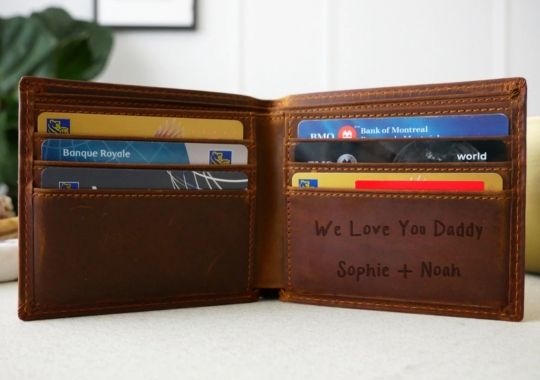Wallets have come a long way since their humble beginnings. As essential accessories for both men and women, wallets have not only served as practical tools for carrying money and valuables but also as fashionable statements reflecting the times they were used in. Join us on a journey through history as we explore the fascinating evolution of wallets and their impact on society.
As Amazon affiliates we may earn a commission if you purchase a product at no cost to you.

Watch this great video.
Ancient Wallets: Tracing the Origins of Wallets
In the ancient world, wallets took on various forms and served as practical tools for carrying money and personal belongings. Let's delve into the intriguing origins of wallets and explore how they evolved throughout history.
Early Pouches and Containers
The concept of wallets can be traced back to ancient civilizations such as Mesopotamia, Egypt, and Greece. In these early societies, people needed a secure way to carry their valuable items, including coins, jewelry, and important documents.
In Mesopotamia, people used small pouches made from animal hides or fabric. These pouches were tied around the waist and hung from a belt, providing a convenient and accessible storage solution. Similarly, ancient Egyptians crafted wallet-like containers known as "scribal palettes." These palettes were used to hold writing instruments, but they also featured compartments for storing small personal items.
Greek Wallets: The "Kibisis"
In ancient Greece, wallets were known as "kibisis." These wallets were typically made from leather or fabric and were designed to be worn by both men and women. The kibisis was often carried by travelers, hunters, and merchants who needed a portable and secure way to carry their coins and other valuables.
The kibisis featured a drawstring closure, ensuring that the contents remained safely stored inside. It was typically worn around the waist or hung from a belt, allowing for easy access and preventing loss or theft.
Roman "Loculus" and Money Purses
In the Roman Empire, wallets took on different forms. The "loculus" was a type of bag or satchel that functioned as a wallet. It was commonly used by soldiers and travelers to carry personal belongings and provisions.
Additionally, Roman citizens carried small purses called "marsupium" or "bursa" to hold their coins. These money purses were often made from leather or fabric and had a drawstring or flap closure. The design ensured that the coins remained secure and prevented them from falling out or being stolen.
The Influence of Silk Road and Medieval Wallets
During the Middle Ages, trade and cultural exchange along the Silk Road brought new influences to wallet design. Wallets became more intricate and decorative, reflecting the artistic styles of different regions. They were often adorned with embroidery, metalwork, or precious gemstones, showcasing the wealth and status of the owner.
Medieval wallets were typically made from leather and featured multiple compartments for organizing coins, bills, and important documents. These wallets were usually carried by merchants, nobles, and clergy who needed a sophisticated way to carry their valuables.
Wrapping Up
The ancient origins of wallets reveal the human desire for organized and secure storage. From the early pouches and containers of Mesopotamia to the intricate wallets of medieval Europe, these accessories have undergone remarkable transformations throughout history.
As we continue our exploration, we will delve into the Renaissance period and the modern era, where wallets experienced further evolution and significance. Stay tuned to discover how wallets adapted to changing times and became not only functional but also fashionable accessories in our daily lives.

Renaissance of Wallets: Evolution and Significance in the Modern Era
The Renaissance period marked a significant turning point in the evolution of wallets. As society underwent a cultural and intellectual rebirth, wallets transformed both in design and significance. Let's delve into this fascinating era and explore how wallets evolved during the Renaissance and their continued relevance in the modern era.
The Rise of Paper Currency
One of the pivotal changes during the Renaissance was the introduction of paper currency. As coins remained the primary form of currency, wallets had to adapt to accommodate both coins and paper money. This shift led to the development of wallets with dedicated compartments or pouches specifically designed to hold paper currency.
Artistic Influences and Embellishments
The Renaissance was an era characterized by artistic expression and attention to aesthetics. Wallets became more than just functional accessories; they became expressions of personal style and social status. Wallets were adorned with intricate embroideries, ornate metalwork, and decorative patterns. They became a canvas for artistic expression and craftsmanship, showcasing the owner's refined taste.
Expansion of Wallet Compartments
As society became more complex, so did the needs of individuals. Wallets began to feature multiple compartments to accommodate various items, such as coins, paper money, identification cards, and personal notes. These compartments allowed for better organization and easy access to different types of valuables.
Customization and Personalization
During the Renaissance, wallets became more personalized and reflective of individual tastes and preferences. Wealthy individuals commissioned artisans to create bespoke wallets, often featuring their family crests, initials, or symbols. This customization added a touch of exclusivity and uniqueness to each wallet, making it a personal statement piece.
The Legacy of Renaissance Wallets in the Modern Era
The impact of the Renaissance on wallet design and significance can still be seen in the modern era. The concept of organizing and carrying personal belongings in a fashionable and practical manner continues to be relevant today.
Wallets have evolved further, incorporating modern materials such as leather, fabric, and synthetic materials. They now feature advanced designs, including RFID-blocking technology for enhanced security. However, the influence of the Renaissance can still be found in the attention to detail, craftsmanship, and aesthetic appeal of contemporary wallets.
Moreover, the idea of wallets as a fashion statement remains strong. People choose wallets that reflect their personal style and preferences. From sleek and minimalist designs to bold and vibrant patterns, wallets today serve not only as practical accessories but also as expressions of individuality.
The Renaissance period had a profound impact on the evolution of wallets. From adapting to the rise of paper currency to embracing artistic influences and personalization, wallets became more than just utilitarian items. They became objects of beauty and status. The legacy of the Renaissance continues to shape the world of wallets, ensuring that they remain functional, fashionable, and meaningful in the modern era.

Popular Wallet Styles and Designs: From Classic to Contemporary
Wallets come in a wide range of styles and designs, catering to diverse tastes and preferences. From classic and timeless options to contemporary and trendy designs, let's explore popular wallet styles that have stood the test of time and those that have emerged as modern favorites.
Classic Bi-fold Wallets
The bi-fold wallet is a timeless design that remains popular to this day. These wallets are characterized by their folding design, typically featuring a single fold in the middle. Bi-fold wallets offer a balance between functionality and compactness, providing ample space for cash, cards, and identification. They often include card slots, a bill compartment, and sometimes even a clear ID window.
Tri-fold Wallets
Tri-fold wallets are another classic style that has been widely used for decades. As the name suggests, these wallets have two folds, dividing the wallet into three sections. Tri-fold wallets offer additional storage capacity with multiple card slots, bill compartments, and extra pockets. While slightly bulkier than bi-fold wallets, they provide more organizational options for those who carry numerous cards or documents.
Minimalist Wallets
In recent years, minimalist wallets have gained popularity among those seeking a sleek and compact option. These wallets prioritize simplicity and slimness, often with a minimalist design that eliminates unnecessary features. Minimalist wallets typically have a slim profile, allowing for easy and comfortable pocket carry. They often include a few card slots and a central compartment for cash, streamlining the essentials and reducing bulk.
Zip-around Wallets
Zip-around wallets offer enhanced security and organization with their full-zipper closure. These wallets fully enclose their contents, ensuring that nothing falls out or gets lost. Zip-around wallets often feature multiple card slots, compartments for bills and coins, and sometimes even additional pockets for small items like keys or SIM cards. Their secure design makes them popular among travelers or individuals who prefer added protection.
Wristlet Wallets
Wristlet wallets combine the functionality of a wallet with the convenience of a wrist strap. These wallets often feature a detachable or integrated strap, allowing them to be worn around the wrist. Wristlet wallets provide easy access to essentials while keeping hands free. They are especially popular among individuals who prefer to carry only the essentials, such as a few cards, cash, and a phone.
RFID-blocking Wallets
With the increasing prevalence of contactless payment technology, RFID-blocking wallets have gained attention. These wallets are designed with special materials that block radio frequency identification (RFID) signals, protecting cards from unauthorized scanning or electronic theft. RFID-blocking wallets come in various styles, ranging from classic designs to contemporary options, ensuring both security and style.
Designer Wallets
Designer wallets offer a blend of fashion and function. These wallets are often crafted from high-quality materials, featuring exquisite craftsmanship and iconic brand logos or patterns. Designer wallets come in various styles, including bi-fold, tri-fold, and zip-around designs, catering to those who appreciate luxury and wish to make a fashion statement.
Innovative Wallets
Innovation has also led to the emergence of unique and unconventional wallet designs. For example, there are modular wallets that allow users to customize their wallet by adding or removing modules based on their needs. There are also slim cardholders that use elastic bands to securely hold cards without the need for traditional slots.
From classic bi-fold and tri-fold wallets to minimalist designs, zip-around options, and innovative styles, the world of wallets offers something for everyone. The choice ultimately comes down to personal preferences in terms of functionality, aesthetics, and individual style. Whether you prefer a timeless design or a cutting-edge wallet, there is a plethora of options available to suit your needs.
Conclusion
Wallets have come a long way throughout history, adapting to changing needs, advancements in technology, and evolving fashion trends. From the ancient pouches of Mesopotamia to the modern digital wallets of the 21st century, these accessories have evolved to become essential tools for carrying our valuables and making transactions.
Frequently Asked Questions FAQs
What is the history of wallets?
Wallets have a rich history dating back to ancient civilizations. They have evolved over time to meet changing needs and fashion trends.
How have wallets transformed in the digital age?
In the digital age, wallets have become digital wallets or e-wallets, offering convenient and secure ways to store and manage payment information on mobile devices.
What are some popular wallet styles?
Popular wallet styles include classic bi-fold and tri-fold wallets, minimalist designs, zip-around wallets, wristlet wallets, and designer wallets.










